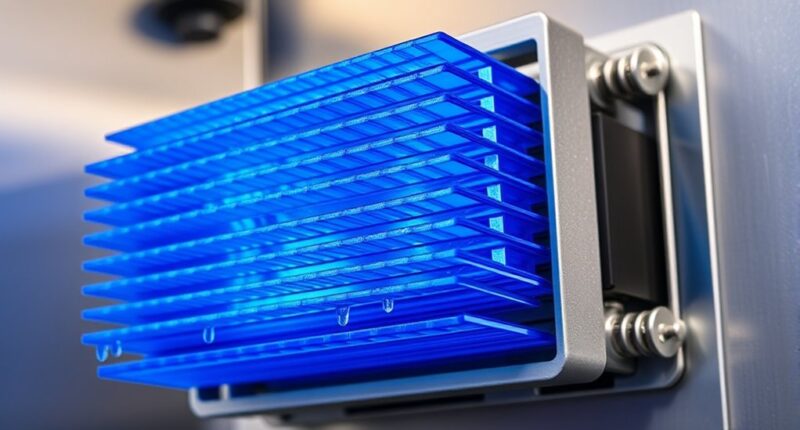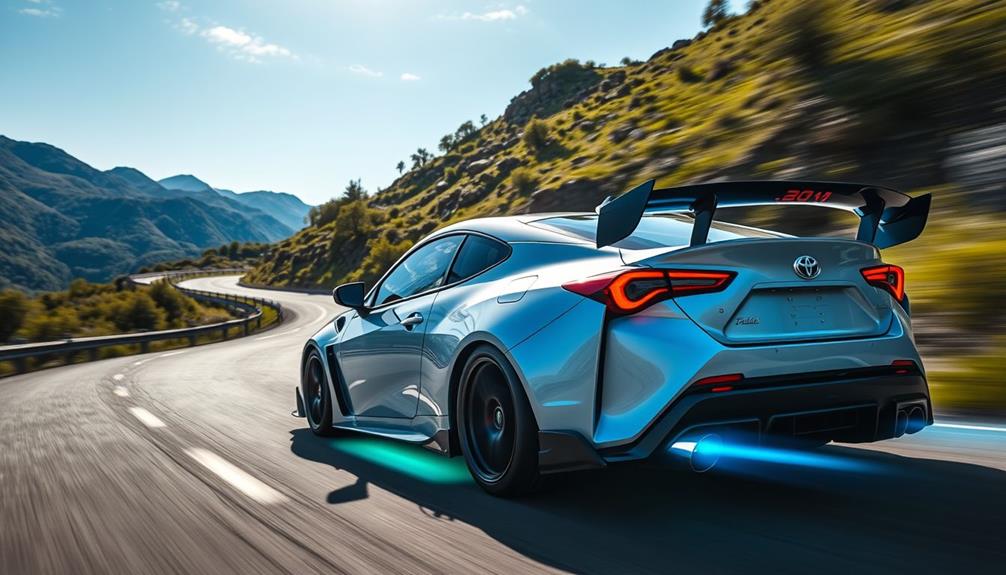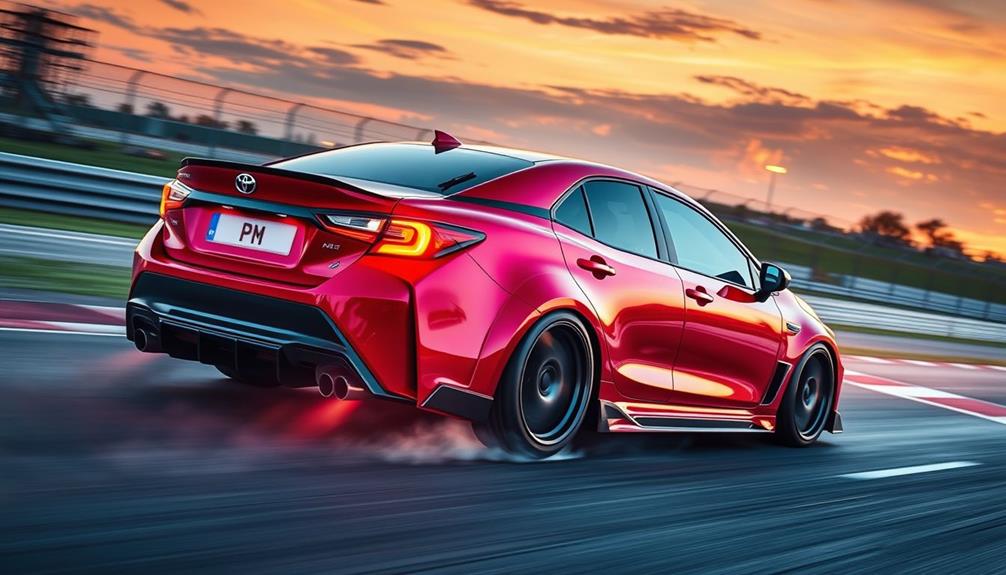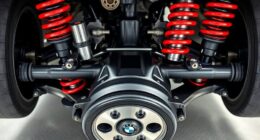To prevent your hybrid inverter from overheating, consider upgrading its cooling system with higher-capacity fans or adjustable speed units for better airflow control. Installing fans near vents or heat sinks improves heat dissipation, while adding vents or mesh panels enhances ventilation. You can also upgrade to heat sinks or thermal pads, and keep the system clean to avoid dust buildup. Implementing these cooling measures can markedly boost efficiency and durability—continue to explore more effective options for ultimate protection.
Key Takeaways
- Install high-quality, adjustable-speed fans near heat sinks or vents to improve airflow and heat dissipation.
- Enhance enclosure ventilation by adding vents, mesh panels, or passive airflow pathways to promote better cooling.
- Incorporate heat sinks or thermal pads on critical components to transfer heat away efficiently.
- Regularly clean dust and debris to maintain optimal cooling performance and prevent heat buildup.
- Consider advanced cooling systems like liquid cooling or heat exchangers for high-capacity or prolonged inverter operation.
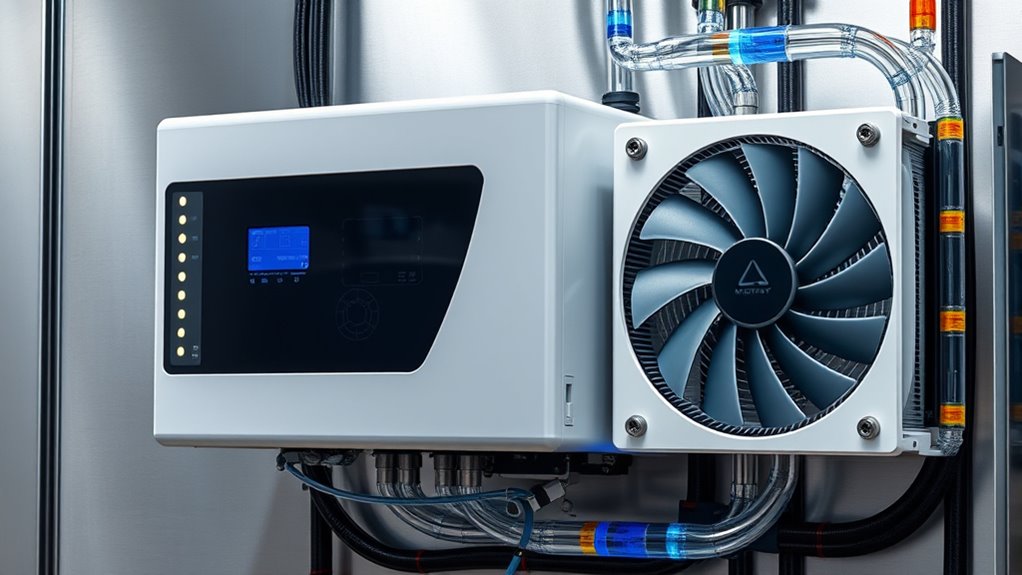
Hybrid inverters are vital components of solar energy systems, but overheating can markedly reduce their efficiency and lifespan. When these devices get too hot, their power conversion drops, and they become more prone to failure. To keep your inverter running smoothly, effective thermal management is essential. One simple yet powerful upgrade is fan integration, which actively cools the unit and prevents heat buildup. Fans help dissipate heat quickly, maintaining an ideal operating temperature and ensuring your inverter performs at its best even during peak sunlight hours.
Installing a fan isn’t complicated, but it makes a significant difference. You should choose a fan that’s compatible with your inverter’s size and heat output. Many models come with adjustable speeds, so you can fine-tune the cooling based on temperature readings or ambient conditions. When you add a fan, ensure it’s positioned to maximize airflow across the most heat-sensitive components. Proper placement is key—placing the fan near vents or heat sinks can dramatically improve heat dissipation. Additionally, consider fan noise levels and energy consumption to avoid creating new issues while solving overheating.
Choose adjustable fans and position them near vents or heat sinks for optimal cooling.
Beyond fan integration, enhancing thermal management involves other strategies that keep your inverter cool. Improving ventilation around the unit allows for better airflow, preventing heat pockets from forming. If your inverter is enclosed in a cabinet, adding vents or mesh panels can boost heat escape routes. Using heat sinks or thermal pads can also help transfer heat away from critical components. These upgrades work together to create a cooling environment that minimizes thermal stress and prolongs the inverter’s lifespan. Incorporating effective cooling techniques can further optimize performance and durability.
Regular maintenance is equally important. Dust and debris accumulation on fans or vents can drastically reduce cooling efficiency. Make it a habit to clean these areas periodically. Monitoring system temperature with sensors can alert you to overheating issues before they cause damage. In some cases, upgrading to a more sophisticated cooling system, like liquid cooling or heat exchangers, might be worthwhile if your setup consistently runs hot under heavy loads.
Frequently Asked Questions
How Often Should Cooling Systems Be Inspected?
You should inspect your cooling systems regularly to guarantee ideal performance. Typically, following your maintenance schedule, inspections should occur at least once every six months. This frequency helps catch any issues early, preventing overheating and potential inverter damage. Keep an eye on signs of dirt or debris buildup, and don’t skip scheduled maintenance to keep your hybrid inverter running smoothly and extend its lifespan.
Can Cooling Upgrades Extend Inverter Lifespan Significantly?
Yes, cooling upgrades can considerably extend your inverter’s lifespan by enhancing thermal management. When you improve cooling systems, your inverter stays cooler, reducing stress on its components. This boosts inverter durability and prevents overheating-related damage. By investing in effective cooling solutions, you guarantee your hybrid inverter operates efficiently for a longer time, saving you maintenance costs and reducing the risk of unexpected failures. Proper thermal management is key to maximizing inverter longevity.
Are There Specific Brands Recommended for Cooling Accessories?
Think of choosing cooling accessory brands as selecting a trusted compass for your journey. While no single brand rules, some recommended cooling products stand out for quality and reliability. Popular recommended cooling products include brands like Arctic, Noctua, and Cooler Master. These trusted cooling accessory brands offer solutions that effectively prevent overheating, ensuring your hybrid inverter runs smoothly and lasts longer. Always research reviews to find the best fit for your system.
What Are the Cost Implications of Advanced Cooling Solutions?
When considering advanced cooling solutions, you should do a cost-benefit analysis to determine if the benefits outweigh the installation expenses. These upgrades can be more costly upfront but help prevent overheating and extend inverter lifespan. You might find that the initial investment pays off through reduced maintenance costs and improved efficiency. Keep in mind, ongoing expenses for maintenance and upgrades are also part of the total cost implications.
Do Cooling Upgrades Void the Inverter Warranty?
You might think a cooling upgrade will instantly void your inverter’s warranty, but that’s not always true. While some manufacturers impose strict warranty implications and cooling upgrade restrictions, others see these enhancements as preventive, not voiding coverage. Always check your inverter’s warranty terms before upgrading. If done properly and within manufacturer guidelines, cooling upgrades can protect your system without risking warranty issues, giving you peace of mind and better performance.
Conclusion
By upgrading your cooling system, you not only prevent overheating but also breathe new life into your hybrid inverter’s performance. Think of it as giving your system a gentle yet mighty shield—protecting it from the heat’s relentless assault. Remember, a well-cooled inverter isn’t just a device; it’s the heartbeat of your energy system. So, don’t wait for trouble—invest in cooling upgrades now and keep your inverter’s power flowing smoothly, come what may.
